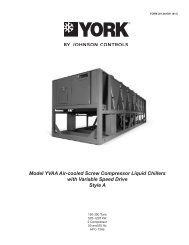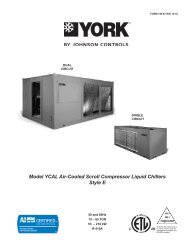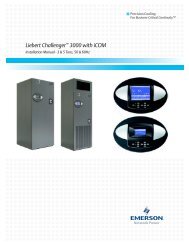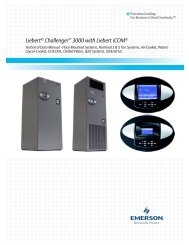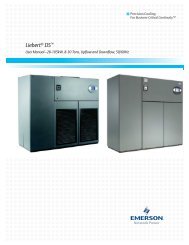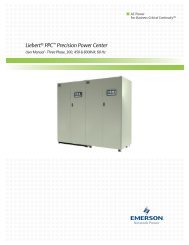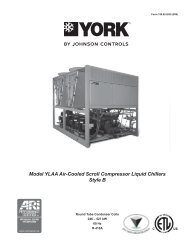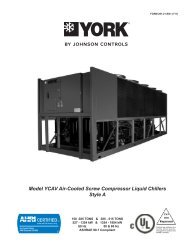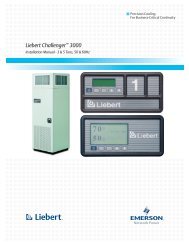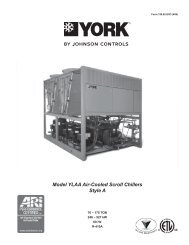Liebert Challenger 3000
Liebert Challenger™ 3000 Operation & Maintenance Manual - DCES
Liebert Challenger™ 3000 Operation & Maintenance Manual - DCES
Create successful ePaper yourself
Turn your PDF publications into a flip-book with our unique Google optimized e-Paper software.
6.3 Blower PackageComponent Operation and MaintenancePeriodic checks of the blower package include: belt, motor mounts, fan bearings, and impellers.6.3.1 Fan Impellers and BearingsFan impellers should be periodically inspected and any debris removed. Check to see if they aretightly mounted on the fan shaft. Rotate the impellers and make sure they do not rub against the fanhousing.Bearings used on the units are permanently sealed and self-lubricating. They should be inspected forsigns of wear when the belt is adjusted. Shake the pulley and look for movement in the fan shaft. Ifany excessive movement is noticed, bearings should be replaced. However, the cause of the wear mustbe determined and corrected before returning the unit to operation.6.3.2 BeltThe drive belt should be checked monthly for signs of wear and proper tension. Pressing in on beltsmidway between the sheave and pulley should produce from 1/2" to 1" (12 to 25 mm) of movement.Belts that are too tight can cause excessive bearing wear.Belt tension can be adjusted by raising or lowering the fan motor base. Loosen nut above motormounting plate to remove belt. Turn nut below motor mounting plate to adjust belt tension. If beltappears cracked or worn, it should be replaced with a matched belt (identically sized). With propercare, a belt should last several years.6.3.3 Air DistributionNOTEAfter adjusting or changing the belt, always be certain that motor base nuts are tightened.The bottom adjustment nut should be finger tight. The top locking nut should be tightenedwith a wrench.All unit models are designed for constant volume air delivery. Therefore any unusual restrictionswithin the air circuit must be avoided. Refer to the following table for recommended free area forproper air flow.Table 17 Recommended free area ft 2 (m 2 ) for grilles or perforated panels at output velocities of550 and 600 fpm (2.8 and 3.1 m/s)Model550 FPM(2.8 m/s)600 FPM(3.1 m/s)60 Hz Units3 Ton 2.5 (0.22) 2.3 (0.21)5 Ton 3.8 (0.34) 3.5 (0.33)50 Hz Units3 Ton 2.9 (0.27) 2.6 (0.24)5 Ton 3.5 (0.33) 3.3 (0.31)Grilles used in raised floors vary in size, the largest being 18" x 6" (46 cm x 15 cm). This type of grillehas approximately 56 in 2 (361 cm 2 ) of free area. Perforated Panels are usually 2' x 2' (61 cm x 61 cm)and have a nominal free area of approximately 108 to 144 in 2 (697 to 929 cm 2 ).NOTEAbsolutely avoid any under-floor restrictions such as clusters of cables or piping. Wheneverpossible, cables and pipes should be run parallel to the air flow. Never stack cables or piping.45



